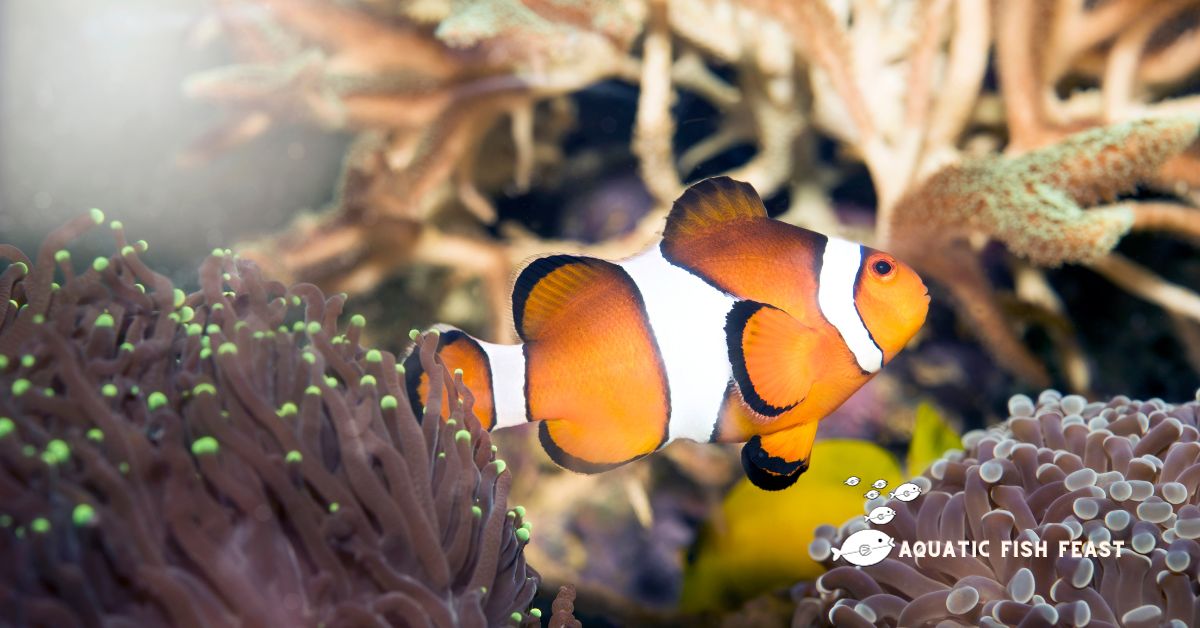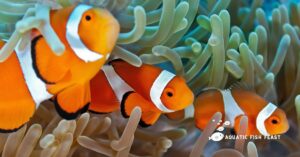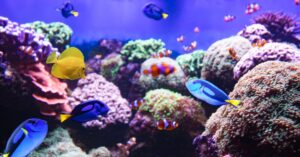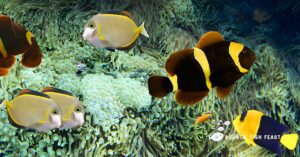Do you want to know what clownfish like to eat? Clownfish mainly feed on plankton and food scraps.
Clownfish bring delight and beauty to aquariums; thus, I adore them. However, one critical thing is that we must first understand them, notably their food and choices, to help us care for them properly.
With its bright colors and energetic nature, aquarium fans love these adorable critters worldwide.
Let me explain what clownfish diet is and how to feed them healthily in this article.
Let’s get started.
See how clownfish eat.
Table of Contents
What Do Clownfish Like To Eat
Clownfish are omnivorous creatures with a broad diet in their natural environment. They eat algae, plankton, small crustaceans, and even tiny creatures.
One unique characteristic of clownfish is their symbiotic association with host sea anemones, which permits them to eat the food leftovers these friendly hosts capture.
If you have clownfish in your tank, recreate their natural food as closely as possible you can. It means you have captured their natural environment so they can strive well.
Fortunately, several commercially available fish feeds can suit their nutritional requirements.
It is perfect to have high-quality pellets, flakes, and frozen feeds such as brine and mysis shrimp. These meals can provide the essential nutrients and resemble the clownfish’s varied diet in its natural environment.
How often to feed clownfish
Now, let’s talk about how often they should be fed. Despite their small size, clownfish have high metabolisms, which allows them to eat many times.
They need frequent food to remain energized. Over the years, I’ve found that they need just a little food two to three times daily.
Of course, your clownfish’s size and activity level should determine their feeding frequency. However, you should keep notes and avoid overfeeding or underfeeding them too.
All I am saying is that you have to study your clownfish feeding habits and adjust to the way they respond when you feed them. All we want is for them to be lively and healthy!
In terms of plants, we can give them cooked chard and spinach.
Clownfish are not selective eaters, but it is always best to be cautious about any unique dietary choices you make for them. Certain folks, like us, don’t have the same dietary preferences.
Giving them various food options will ensure that your clownfish receive a well-rounded diet.
Again, avoid overfeeding them because excess food can lead to low water quality issues and health problems.
How To Feed Clownfish Frozen Food
Clownfish are good at eating frozen feed. Frozen feed is highly nutritious and can boost immunity.
Clownfish feeding with frozen foods can also be used as a medicine substitute when they are sick.
Frozen feed comes in one sheet, just under B5 size, and can be purchased for around 300 yen per sheet.
The frozen feed given to clownfish is frozen brine shrimp and frozen white shrimp.
Frozen white shrimp are larger and suitable for clownfish over 4 cm.
However, the recommended bait food for clownfish is to use artificial feed and frozen feed.
Different clownfish have different food preferences. Some clownfish prefer artificial feed, while others prefer frozen feed.
Some clownfish do not recognize artificial feed as food.
Ideally, feed your clownfish artificial food regularly and occasionally give it frozen food to give it strength when it gets sick.
Buying a sheet of frozen feed and keeping it in stock would be a good idea.
What Do Clownfish Eat In The Wild?
They typically consume on zooplankton, a wide range of minute invertebrates that float in the water layer.
Examples are copepods, various larvae, fish eggs, and little shrimp. The anemone also provides nutrients like meals trapped in the tentacles.
Clownfish waste closes in return for protection and the odd feast, allowing anemones to consume the excrement and get nutrition.
That is one of the ocean’s most unusual reciprocal symbiotic connections. They also like to consume algae, vegetation, and tiny animals.
Black worms, copepods, various larvae, fish eggs, larvae, shrimp, mollusks, seagrasses, and clownfish all feed on phytoplankton, a free-flowing plant.
Young clownfish will need to be fed close to their safety zone – this will be a small area they will almost always be around until they get larger.
Once they grow bigger, you will still need to feed them in areas without a strong water flow to prevent difficulty feeding.
Adults will need to be fed twice a day, and little ones will need to be fed 3 or 4 times daily.
Only give them what they can eat within 3 minutes, and clean excess food from the tank to maintain optimal water retention.
What Do Clownfish Eat In An Aquarium?
You can feed clownfish in the aquarium once a day. If you plan on breeding clownfish, feeding can be more than once.
Ensure that no leftover food is left in your tank to rot because it can lead to the smell of water and pose a danger to the fish.
Their primary food sources in aquariums include:
Fish Pellets: This is a favorite meal for clownfish beginners and experts. Fish pellets help to provide balanced food nutrients, such as carbs, protein, and fat; your fish needs nutrients to your clownfish needs to grow big and healthy.
Fish pellets only struggle to be removed if left uneaten since most settle to the bottom. Fortunately, floating variants solve this.
Even though fish pellets are fantastic, you should only buy high-quality for clownfish.
Buying the wrong fish pellets might harm your fish since each fish needs different nourishment.
Fish Flakes: The only other clownfish diet option besides fish pellets is. Like pellets, fish flakes provide a complete, well-balanced diet for your clownfish.
Fish flakes decompose fast, polluting your tank or aquarium. However, adding only a few flakes and replacing water filters will prevent it.
Frozen Food: Supplement fish pellets or flakes with frozen food like bloodworms, larvae, and tiny crustaceans like mysis shrimp, brine shrimp, and copepods.
Such diets are virtually as healthy as live food and contain minerals and vitamins that your fish may not get from fish flakes or pellets.
Here are a few tips to enhance your clownfish feeding experience:
- You can use feeding tools such as feeding rings or target sticks to direct the food to specific aquarium areas to encourage natural foraging behavior. This enriches your clownfish and prevents the food from getting lost in the filtration system.
- And one last thing: always make sure to remove any leftover food promptly. This will help maintain the quality of the water in their environment.
- Always Keep it clean, keep it fresh!
My Final Take
Understanding what clownfish like to eat is vital for their overall health and happiness. Keeping them on different diets that closely resemble their natural food sources gives them the life they need to expand and live healthily in their aquarium environment.
One other thing you must do is pay close attention to their feeding behavior and adjust as needed to meet their dietary needs.
As long as they’re well-nourished, your little aquatic fishes will continue to delight and captivate aquarium enthusiasts for years.




